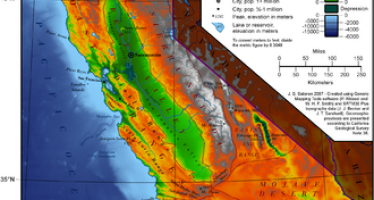Board chair’s upbeat take on bullet train at sharp odds with MSM

 When James Fallows of The Atlantic came out last week in strong support of the California high-speed rail project, I responded with an unnecessarily snarky piece — sorry, James — headlined “7 ways James Fallows is wrong about the CA bullet train.” In it, I said the author was judging the project in a vacuum instead of evaluating it based on its history and its legal obligations. That led Dan Richard, the chair of the California High-Speed Rail Authority, to send Fallows a point-by-point rebuttal of my arguments.
When James Fallows of The Atlantic came out last week in strong support of the California high-speed rail project, I responded with an unnecessarily snarky piece — sorry, James — headlined “7 ways James Fallows is wrong about the CA bullet train.” In it, I said the author was judging the project in a vacuum instead of evaluating it based on its history and its legal obligations. That led Dan Richard, the chair of the California High-Speed Rail Authority, to send Fallows a point-by-point rebuttal of my arguments.
So how about we let others join in the fun? What do the mainstream media have to say about my key three points?
Their conventional wisdom is a lot closer to my deep skepticism than to Richard’s rosy scenarios, that’s for sure.
Point 1: There are not nearly adequate funds available to complete the $68 billion project in the way promised to voters in 2008 who approved Proposition 1A, giving the bullet train $9.95 billion in state bonds as seed money.
As Politico reported on Feb. 8, this is already a huge legal obstacle based on Prop. 1A’s language — not a distant headache on the horizon.
Judge Michael Kenny ruled that the state could not sell future bonds to finance the first leg of construction until they redid the business plan to specify sources of funding “that were more than merely theoretically possible.”
As for the $250 million in cap-and-trade funds Gov. Jerry Brown secured for the rail project this fiscal year, as Associated Press noted on Jan. 14 …
It also is just a tiny fraction of the overall price tag for high-speed rail, currently at $68 billion.
And as the L.A. Times reported on Feb. 28, this appropriation is deeply unpopular with environmentalists — and it offers …
… significant legal risks. The state law that set up the limits on greenhouse gases and the cap-and-trade system calls for investments that will reduce emissions by 2020 to the levels that existed in 1990, some experts say. The state’s nonpartisan Legislative Analyst’s Office, noting the bullet train would not be in operation until after 2020, has questioned the legality of using the cap-and-trade funding for rail construction.
 As for Dan Richard’s claim that significant private financing is just around the corner, I await Dan naming a single company that would have any interest in partnering with the state of California on a multibillion-dollar project without revenue or ridership guarantees, which are banned by Prop. 1A. Dan won’t be able to because there aren’t any.
As for Dan Richard’s claim that significant private financing is just around the corner, I await Dan naming a single company that would have any interest in partnering with the state of California on a multibillion-dollar project without revenue or ridership guarantees, which are banned by Prop. 1A. Dan won’t be able to because there aren’t any.
As for the notion that the federal government might foot nearly the entire bill for one state’s extremely expensive project –as some CA bloggers hope — I can’t cite an MSM piece saying that’s not true, because it’s not even something the MSM considers in the realm of human possibility.
And, no, it’s not just those evil House Republicans who oppose further federal funding than the $3.5 billion the project has gotten so far. Patty Murray, the Washington Democrat who is now chair of the Senate budget committee, came out as an opponent of federal funding for such projects in 2011.
Point 2: The legal challenges the project faces because of Prop. 1A restrictions are likely to be impossible to overcome.
Judge Michael Kenny didn’t just say that before construction began, the state has to have $31 billion in hand to build a “viable” first operating segment of 300 miles that could make money even if the full system was never completed. He said the state had to complete environmental reviews for all 300 miles. It’s not even one-tenth complete, with only 27 miles having clearances.
This is from the Hanford (CA) Sentinel’s reporting on Feb. 4:
Kenny also ruled that the Authority needed to complete environmental analyses for the segment before construction begins.
As for Richard’s confidence in the bullet train’s lawyers, as the Sentinel notes, the legal team instead looks more like the Keystone Kops:
Kings County opponents celebrated the [August 2013 and November 2013] rulings as at least partial vindication, but Authority officials said the project was proceeding on schedule and implied that the rulings were a minor inconvenience.
In the appeal [filed in January], the Authority argued just the opposite.
“The trial court’s approach to these issues cripples government’s ability to function. … Action by this court is urgently required to avoid compromising the Authority’s ability to build the system quickly and economically, as intended by the Legislature and the voters,” the appeal states.
And keep in mind that in Silicon Valley, rich cities have basically vowed to block related construction forever using NIMBY tactics. These tactics have a long history of winning in California — especially when you have very skilled attorneys with very deep-pocket clients.
Point 3: What the state proposes isn’t even high-speed rail.
 Because of fears of just the sort of corner-cutting we’re now seeing, Prop. 1A required that the bullet train get from downtown Los Angeles to downtown San Francisco in no more than two hours and 40 minutes. But under the governor’s “blended” plan using regular rail from San Francisco to San Jose and from the northern edges of the L.A. exurb to downtown L.A., that means about 100 miles of the trip will be at conventional train speeds and 410 miles at bullet-train speeds.
Because of fears of just the sort of corner-cutting we’re now seeing, Prop. 1A required that the bullet train get from downtown Los Angeles to downtown San Francisco in no more than two hours and 40 minutes. But under the governor’s “blended” plan using regular rail from San Francisco to San Jose and from the northern edges of the L.A. exurb to downtown L.A., that means about 100 miles of the trip will be at conventional train speeds and 410 miles at bullet-train speeds.
If you make the generous concession that the conventional trains will go 100 miles at 100 mph, taking 60 minutes, and if you have transfer times of five minutes for each of the train switches, that means the bullet train will have to cover 410 miles in 90 minutes, going 273 mph, to comply with the 160-minute limit in state law.
I repeat, 273 mph. I repeat, 273 mph. I repeat, 273 mph.
That’s average speed, not top speed.
Nevertheless, Richard says that’s not going to be a problem. He says …
“… the independent Legislative Peer Review Group looked at the planning and concluded that at present, our design would allow for that trip to occur in 2 hours and 32 minutes.”
What does the MSM say? Even though I have never seen a piece that breaks down the math of the CHSRA’s claims as I did above, most journos are very skeptical, and so are many experts, as this L.A. Times piece from March 27 notes.
But there’s another wrinkle here. In his response to my original post, Richard seems to take the 160-minute provision of Prop. 1A seriously. But as the L.A. Times reported on June 9 of this year, the rail authority is trying to play semantic games to get out of the obligation — because it’s an obligation it can’t meet:
Dan Richard, chairman of the authority, said the state would deliver a system that meets all legal requirements of the ballot measure.
“We are not trying to parse words and hide behind legal technicalities,” he said.
But critics and opponents, including some key players from the project’s past, say the rail authority is trying to circumvent the basic intent of the protections because the existing plan for the Los Angeles-to-San Francisco line can’t meet them.
The unusual specificity of Proposition 1A has been cited by bullet train promoters and critics to bolster their positions. And both sides have put the language and procedures set out in an 8,000-word piece of legislation underlying the ballot measure under an interpretive microscope. One example: Does a requirement to “design” the train so it can travel from L.A. to San Francisco in two hours and 40 minutes mean the state has to provide such service?
“This bond issue was extraordinary,” said Quentin Kopp, a former state senator, state court judge and former chairman of the rail authority, when the restrictions were written. “I can’t recall any general obligation bond issue that incorporated legal provisions to the extent this one does.”
In Kopp’s view, the state legislation and subsequent ballot measure were a conscious effort by the Legislature to place binding safeguards on the biggest infrastructure project in California history.
Rep. Alan Lowenthal (D-Long Beach), a former state senator who wrote many of the restrictions, said: “We didn’t put them in as guidelines…. It was really clear what we wanted.”
In 2008, 160 minutes meant 160 minutes in California. In 2014? Well, that’s open to debate.
I look forward to Dan Richard’s response to my response to his response to my response to James Fallows. Will he argue again that I’m a “rabid” bullet-train hater? Or will he concede that “rabid” though I may be, I’ve got the MSM generally on my side?
If he says the MSM is with him, Dan should offers specifics, and not just boosterism from the edit page of the Fresno Bee.
We shall see.
In the mean time, I sure hope that Fallows talks to Ralph Vartabedian of the L.A. Times or Mike Rosenberg of the San Jose Mercury-News or to former Democratic state Sens. Quentin Kopp, Alan Lowenthal or Joe Simitian. When that happens, he will see that it’s not just blowhard libertarian bloggers who believe the bullet train is a debacle.
It’s lots of people — including many of the project’s original true believers.
Related Articles
Corrections Realignment Without Vote
Commentary JUNE 7, 2011 By KATY GRIMES State Corrections Secretary Matthew Cate announced at a news conference earlier today that
Fresno taxpayers object to misleading petition title and summary
A group of Fresno taxpayers hoping to overturn the city’s recent water rate hike has filed a formal complaint accusing
CA economic ranking renews debate
For those who put a lot of stock in statistics, it’s a good month for California. The Golden State has



